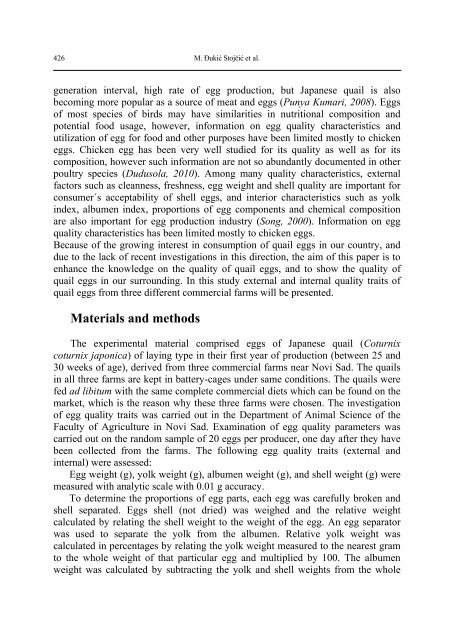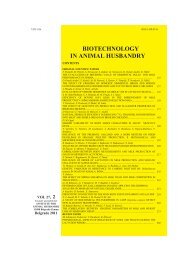Biotechnology in Animal Husbandry - Institut za Stočarstvo
Biotechnology in Animal Husbandry - Institut za Stočarstvo
Biotechnology in Animal Husbandry - Institut za Stočarstvo
You also want an ePaper? Increase the reach of your titles
YUMPU automatically turns print PDFs into web optimized ePapers that Google loves.
426<br />
M. Đukić Stojčić et al.<br />
generation <strong>in</strong>terval, high rate of egg production, but Japanese quail is also<br />
becom<strong>in</strong>g more popular as a source of meat and eggs (Punya Kumari, 2008). Eggs<br />
of most species of birds may have similarities <strong>in</strong> nutritional composition and<br />
potential food usage, however, <strong>in</strong>formation on egg quality characteristics and<br />
utili<strong>za</strong>tion of egg for food and other purposes have been limited mostly to chicken<br />
eggs. Chicken egg has been very well studied for its quality as well as for its<br />
composition, however such <strong>in</strong>formation are not so abundantly documented <strong>in</strong> other<br />
poultry species (Dudusola, 2010). Among many quality characteristics, external<br />
factors such as cleanness, freshness, egg weight and shell quality are important for<br />
consumer´s acceptability of shell eggs, and <strong>in</strong>terior characteristics such as yolk<br />
<strong>in</strong>dex, albumen <strong>in</strong>dex, proportions of egg components and chemical composition<br />
are also important for egg production <strong>in</strong>dustry (Song, 2000). Information on egg<br />
quality characteristics has been limited mostly to chicken eggs.<br />
Because of the grow<strong>in</strong>g <strong>in</strong>terest <strong>in</strong> consumption of quail eggs <strong>in</strong> our country, and<br />
due to the lack of recent <strong>in</strong>vestigations <strong>in</strong> this direction, the aim of this paper is to<br />
enhance the knowledge on the quality of quail eggs, and to show the quality of<br />
quail eggs <strong>in</strong> our surround<strong>in</strong>g. In this study external and <strong>in</strong>ternal quality traits of<br />
quail eggs from three different commercial farms will be presented.<br />
Materials and methods<br />
The experimental material comprised eggs of Japanese quail (Coturnix<br />
coturnix japonica) of lay<strong>in</strong>g type <strong>in</strong> their first year of production (between 25 and<br />
30 weeks of age), derived from three commercial farms near Novi Sad. The quails<br />
<strong>in</strong> all three farms are kept <strong>in</strong> battery-cages under same conditions. The quails were<br />
fed ad libitum with the same complete commercial diets which can be found on the<br />
market, which is the reason why these three farms were chosen. The <strong>in</strong>vestigation<br />
of egg quality traits was carried out <strong>in</strong> the Department of <strong>Animal</strong> Science of the<br />
Faculty of Agriculture <strong>in</strong> Novi Sad. Exam<strong>in</strong>ation of egg quality parameters was<br />
carried out on the random sample of 20 eggs per producer, one day after they have<br />
been collected from the farms. The follow<strong>in</strong>g egg quality traits (external and<br />
<strong>in</strong>ternal) were assessed:<br />
Egg weight (g), yolk weight (g), albumen weight (g), and shell weight (g) were<br />
measured with analytic scale with 0.01 g accuracy.<br />
To determ<strong>in</strong>e the proportions of egg parts, each egg was carefully broken and<br />
shell separated. Eggs shell (not dried) was weighed and the relative weight<br />
calculated by relat<strong>in</strong>g the shell weight to the weight of the egg. An egg separator<br />
was used to separate the yolk from the albumen. Relative yolk weight was<br />
calculated <strong>in</strong> percentages by relat<strong>in</strong>g the yolk weight measured to the nearest gram<br />
to the whole weight of that particular egg and multiplied by 100. The albumen<br />
weight was calculated by subtract<strong>in</strong>g the yolk and shell weights from the whole




